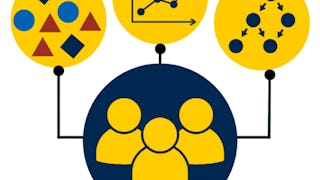In “Network Modeling and Analysis in Python,” you will learn how different types of network analysis can be used to make sense of complex systems. You’ll learn how algorithms can be used to better understand disease epidemics, human community structure, and the flow of information on social media. This course combines network theory with empirical analysis of real-world networks using the Python library NetworkX. You’ll learn about community structure in networks as well as several popular algorithms for community detection and applications.



Network Modeling and Analysis in Python
This course is part of More Applied Data Science with Python Specialization

Instructor: Daniel Romero
Included with 
Recommended experience
What you'll learn
Understand the fundamental principles underlying network structures and apply NetworkX to analyze these principles in real-world networks.
Describe the practical uses of the community detection problem and use algorithms to detect and evaluate community structure in real networks.
Explain the value and applications of network generation models, learn their limits and strengths, and employ them to create synthetic networks.
Identify several basic diffusion models and implement them to run simulations using real and synthetic networks.
Skills you'll gain
Details to know

Add to your LinkedIn profile
June 2025
14 assignments
See how employees at top companies are mastering in-demand skills

Build your subject-matter expertise
- Learn new concepts from industry experts
- Gain a foundational understanding of a subject or tool
- Develop job-relevant skills with hands-on projects
- Earn a shareable career certificate

There are 4 modules in this course
In this module, you will continue learning about the foundational concepts and structural properties that characterize connectivity in networks when considering node attributes. You will explore the principle of homophily or assortative mixing, which explains the tendency of nodes to connect with others that are similar to themselves, and reciprocity, which addresses the mutual linkage between nodes. The module will also cover the concept of structural holes, which highlights the advantages of nodes positioned between unconnected network clusters, and the k-core decomposition method, used to identify cohesive subgroups within the network.
What's included
5 videos10 readings3 assignments1 programming assignment1 discussion prompt1 ungraded lab
This module covers Community Structure in networks: the organization of nodes in a network into clusters or communities, where nodes within the same community have a higher density of connections within their community than across other communities. We explore algorithms to identify communities in networks and evaluate them. Key topics include Modularity, a measure that quantifies the strength of the division of a network into modules or communities; the Girvan-Newman algorithm, a method that systematically removes edges from the network to find the best division based on edge betweenness centrality; Agglomerative Hierarchical Clustering, a technique that builds a hierarchy of clusters by progressively merging groups based on their distance or similarity; and Label Propagation, an algorithm for detecting communities based on spreading labels throughout the network and forming communities based on the dominant label. We also discuss applications to the community detection problem in real-world scenarios.
What's included
8 videos1 reading4 assignments1 programming assignment1 ungraded lab1 plugin
This module expands on network generative models, building on previously covered models such as Small-World and Preferential Attachment models. We'll explore the Erdős-Rényi model, which connects nodes randomly and serves as a baseline for understanding random graph theory. The module also covers the Stochastic Block Model, which is useful for modeling community structures by grouping nodes and connecting them based on group membership. Additionally, we explore the Configuration Model, which is used for creating random networks that maintain a given degree distribution.
What's included
5 videos1 reading3 assignments1 programming assignment1 ungraded lab
This module explores how ideas, diseases, and information spread in networks using models like SI, SIS, SIR, Independent Cascade, and Linear Threshold. Learners will simulate these models with Python, modify them, and tackle the influence maximization problem, identifying key nodes to optimize information or behavior spread.
What's included
13 videos3 readings4 assignments1 programming assignment1 ungraded lab
Earn a career certificate
Add this credential to your LinkedIn profile, resume, or CV. Share it on social media and in your performance review.
Instructor

Offered by
Explore more from Data Analysis

University of Michigan

University of Michigan

University of Michigan
Why people choose Coursera for their career





Open new doors with Coursera Plus
Unlimited access to 10,000+ world-class courses, hands-on projects, and job-ready certificate programs - all included in your subscription
Advance your career with an online degree
Earn a degree from world-class universities - 100% online
Join over 3,400 global companies that choose Coursera for Business
Upskill your employees to excel in the digital economy
Frequently asked questions
Access to lectures and assignments depends on your type of enrollment. If you take a course in audit mode, you will be able to see most course materials for free. To access graded assignments and to earn a Certificate, you will need to purchase the Certificate experience, during or after your audit. If you don't see the audit option:
The course may not offer an audit option. You can try a Free Trial instead, or apply for Financial Aid.
The course may offer 'Full Course, No Certificate' instead. This option lets you see all course materials, submit required assessments, and get a final grade. This also means that you will not be able to purchase a Certificate experience.
When you enroll in the course, you get access to all of the courses in the Specialization, and you earn a certificate when you complete the work. Your electronic Certificate will be added to your Accomplishments page - from there, you can print your Certificate or add it to your LinkedIn profile. If you only want to read and view the course content, you can audit the course for free.
If you subscribed, you get a 7-day free trial during which you can cancel at no penalty. After that, we don’t give refunds, but you can cancel your subscription at any time. See our full refund policy.
More questions
Financial aid available,

